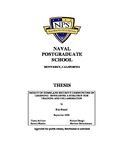MORPHODYNAMIC CLASSIFICATION OF COASTAL REGIONS USING DEEP LEARNING THROUGH DIGITAL IMAGERY COLLECTION
| dc.contributor.advisor | Orescanin, Mara S. | |
| dc.contributor.author | Herrmann, David W. | |
| dc.date.accessioned | 2019-02-13T22:48:53Z | |
| dc.date.available | 2019-02-13T22:48:53Z | |
| dc.date.issued | 2018-12 | |
| dc.identifier.uri | https://hdl.handle.net/10945/61381 | |
| dc.description.abstract | The DoD is investing in autonomy, AI, and machine learning. Deep learning, a sub-field of machine learning is increasing due to newer and cheaper hardware, new algorithms, and big data. Deep learning uses a neural network with multiple weighted layers designed to learn hierarchical feature representations. This research uses the technique of transfer learning, which takes the well-constructed architecture of a source model and retrains it to a target data set—in this case, different coastal landscapes. Eight different classes were trained with oblique (≥ 45°) images. An average accuracy of 95% correct identification was achieved through validation testing. Carmel River State Beach is a known morphodynamic site that changes seasonally. Five different stitched together <10° off NADIR mosaics of this site were selected to test the model’s ability to detect and correctly label areas of change over time. The mosaics were broken into four quadrants of equal area to increase homogeneity of the features. The two landward quadrants showed successful label and change detection; the seaward quadrants showed poor results attributed to smearing and gradient distortion from the stitching process. Successful transfer learning was accomplished with high accuracy; angle differences and stitching caused mislabeling. Larger datasets with single images from multiple angles may reduce labeling error. Multi-label and multispectral approach will enhance and broaden the application of this process. | en_US |
| dc.description.uri | http://archive.org/details/morphodynamiccla1094561381 | |
| dc.publisher | Monterey, CA; Naval Postgraduate School | en_US |
| dc.rights | This publication is a work of the U.S. Government as defined in Title 17, United States Code, Section 101. Copyright protection is not available for this work in the United States. | en_US |
| dc.title | MORPHODYNAMIC CLASSIFICATION OF COASTAL REGIONS USING DEEP LEARNING THROUGH DIGITAL IMAGERY COLLECTION | en_US |
| dc.type | Thesis | en_US |
| dc.contributor.secondreader | Olson, Derek | |
| dc.contributor.department | Oceanography | |
| dc.subject.author | machine learning | en_US |
| dc.subject.author | neural networks | en_US |
| dc.subject.author | coastal landscape | en_US |
| dc.subject.author | coastal imagery | en_US |
| dc.subject.author | remote sensing | en_US |
| dc.subject.author | data processing | en_US |
| dc.subject.author | artificial intelligence | en_US |
| dc.subject.author | deep learning | en_US |
| dc.description.service | Lieutenant Commander, United States Navy | en_US |
| etd.thesisdegree.name | Master of Science in Meteorology and Physical Oceanography | en_US |
| etd.thesisdegree.level | Masters | en_US |
| etd.thesisdegree.discipline | Meteorology and Physical Oceanography | en_US |
| etd.thesisdegree.grantor | Naval Postgraduate School | en_US |
| dc.identifier.thesisid | 30582 | |
| dc.description.distributionstatement | Approved for public release; distribution is unlimited. |
Files in this item
This item appears in the following Collection(s)
-
1. Thesis and Dissertation Collection, all items
Publicly releasable NPS Theses, Dissertations, MBA Professional Reports, Joint Applied Projects, Systems Engineering Project Reports and other NPS degree-earning written works.





